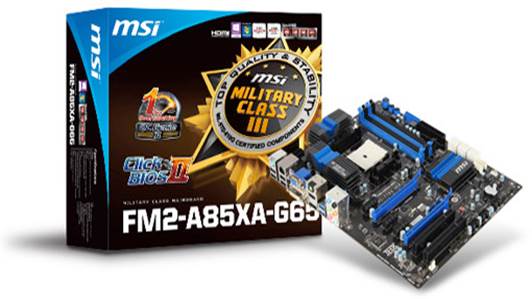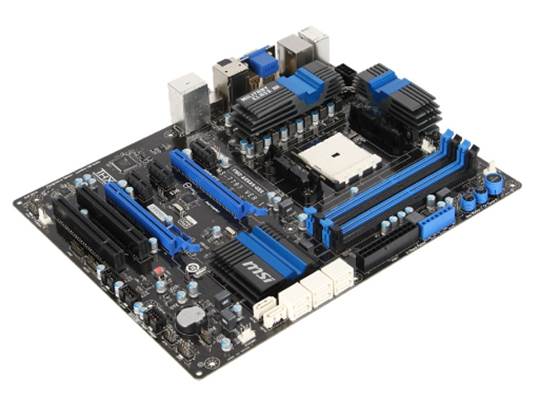Lots of expansions slots and fast
performance, but too pricey for a Trinity system
The A85XA-G65 was slightly faster than
the Gigabyte and AS Rock A75 motherboard
·
Board: On-board power and reset switches; good
overclocker; plenty of expansion options
·
Bored: Expensive compared to A75-based boards
·
Product code: A85XA-G65
·
Price: $129

Thankfully, not all A85X chipset
motherboards cost nearly twice the price of the two A75 motherboards we’ve
tested this month. MSI’s great-looking A85XA-G65 retails for a more reasonable
$129, and while this is still $39 more than the cheapest Socket FM2 examples on
test, at least it goes some way towards justifying the extra outlay.
It’s the only ATX motherboard on test, for
a start, and as such, it has far more expansion slots than the other boards,
with two PCI, three 1x PCI-E and two 16x PCI-E slots more than enough options
for the various combinations of TV tuner cards and sound cards you could
assemble. Even if you install two dual-slot graphics cards, the extra PCB
real-estate means that you’ll still have access to one PCI slot and one 1x
PCI-E slot. Sporting an A85X chipset, the A85XA-G65 offers a total of 16 PCI-E
lanes if you were to use two discrete graphics cards in CrossFireX mode, with
each slot getting eight lanes.
The PCB bristles with features too.
Compared to all the other boards on test, it has the most fan headers, the most
SATA 6Gbps ports and the best cooling. It’s also the only board to offer
on-board power, reset and CMOS clear switches. The layout is excellent too,
with the majority of the SATA ports mounted parallel to the PCB. Meanwhile, the
motherboard power connectors are located right at the edge of the PCB, as are
the power and reset switches. The A85XA-G65 also includes MSI’s OC Genie
overclocking feature, while the EFI system is clear and easy to use as well.
Whichever monitor you own, the A85XA-G65
will be able to cater for it, with VGA, DVI-D, DisplayPort and HDMI connectors
all available on the rear panel, along with two USB 3 ports (a further two are
available via an on-board header), plus 8-channel audio and an optical S/PDIF
output.
Performance
As with the Asus F2A85-M Pro, the A85XA-G65
was slightly faster than the Gigabyte and AS Rock A75 motherboard. Its score of
1,038 in our image editing test was 36 points clear of the Gigabyte, and the
MSI’s video encoding score of 2,025 was the fastest on test. It was the
quickest again in the multi-tasking test, although its lead over the Gigabyte
was a less substantial 15 points here. Overall, this gave it the fastest score
on test of 1,411; 39 points ahead of the Gigabyte.
Its SATA 6Gbps read speeds were a little
slower than we’re used to seeing from the latest Intel-based motherboards, and
its write speeds were noticeably lower, with nearly 100MB/ sec being lopped off
the maximum speed we’ve seen from our OCZ Vertex 3 SSD on Intel motherboards.
However, we can’t hold this against the A85XA-G65, as all the boards on test
returned similar results.
In our Skyrim test, using the on-board
Radeon HD 7660D GPU, the A85XA-G65 managed a minimum frame rate of 26fps, which
was on a par with the other boards on test. We then installed our GeForce GTX
680 2GB graphics card for our Crysis 2 test, and the A85XA-G65 returned a
minimum frame rate of 48fps again roughly the same as the others on test.
We then headed into the EFI to begin
overclocking, and we quickly got our A10-5800K stable at 4.4GHz using a vcore
of 1.485V, while also disabling AMD’s Cool “n” Quiet and the C6 State options.
It recognized our 2,133MHz memory correctly and set the right timings too. We
then managed to push it another 100MHz to 4.5GHz, matching the Gigabyte board,
while using a vcore of 1.5V. Any more than this resulted in either instability
or the CP throttling.

We also pushed the GPU to 1GHz without
needing to touch any other voltages. The combination resulted in some useful
performance gains; the image editing test score rose by 45 points, the video
encoding score by 137 points and the multi-tasking test score rose by over 60
points, with all but the image editing test proving to be the fastest resulted
on test. It managed a 131-point gain in the overall score of our Media
Benchmarks suite with a score of 1,500 again the fastest on test, while Skyrim
saw a handy leap from a minimum frame rate of 26fps to 28fps.
Clearly, if you’ll be using the on-board
GPU to play games, overclocking the CPU and GPU elements of AMD’s ne APUs
yields noticeable gains. Sadly, Crysis 2 didn’t see much of an increase with a
discrete GPU installed, with just 1fps being added to the minimum frame rate.
Meanwhile, in term of power consumption, the system drew 145W from the wall at
stock speed under load, and this rose to 210W once we’d overclocked the system.
Conclusion
The A85XA-G65 proved itself to be a good
performer, a capable overclocker, and a board with plenty of features and
expansion possibilities. Its excellent EFI, combined with power and reset
switches, great layout and abundance of ports means that you get more for the
extra outlay compared to the A75 chipset motherboards on test, although only if
your budget gaming system includes a full-sized ATX case.
However, these extra gubbins come at a
cost, and cost is an important factor when building a budget rig. It may be a
great motherboard that’s significantly cheaper than Asus’ offering, but AMD’s
APUs are all about gaming on a budget; if you don’t need the extra expansion
room then Gigabyte’s GA-F2A75M-D3H offers better value for your average budget
build.